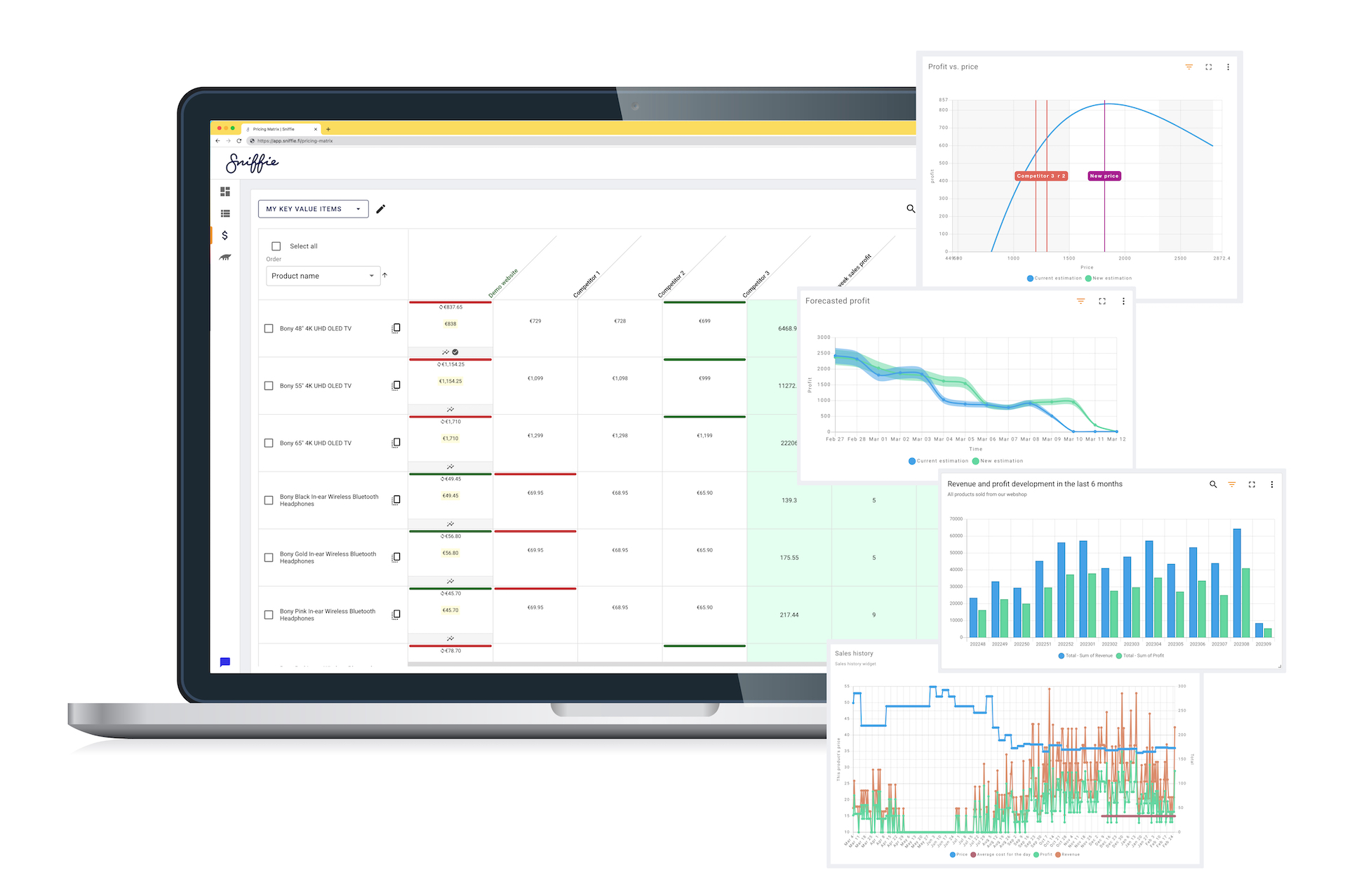Effective pricing is a cornerstone of your business strategy, directly impacting revenue, market share, and overall profitability. Modern markets are dynamic, influenced by ever-changing customer preferences, competitor actions, and economic fluctuations. In response, price optimization software has emerged as a crucial tool that empowers businesses to adapt to these shifts and make informed pricing decisions. Indeed, as businesses have increasingly recognized the pivotal role pricing plays in their success, the use of price optimization software has grown significantly in the recent years.
In this article, we delve into the details of price optimization software. We’ll uncover what it does, how it works, its core concepts, look at a real-life example, and finally discuss some important steps businesses should take before using this game-changing technology.
The Functionality of Price Optimization Software
Price optimization involves determining the ideal price that aligns with your company’s specific goals, for instance boosting revenue, increasing sales, or maximizing profits. It’s essential to note, however, that price optimization doesn’t dictate your overall business strategy, but is used to complement and enhance it by leveraging data-driven insights.
Price optimization software is a sophisticated system that analyzes a multitude of variables to recommend optimal prices for products and services.
At its core, price optimization software is a sophisticated system that analyzes a multitude of variables to recommend optimal prices for products and services. It goes beyond traditional pricing approaches by integrating data-driven insights, predictive analytics, and machine learning algorithms. By taking into account factors such as historical sales data, competitor pricing, market trends, and customer behavior, the software generates pricing strategies that strike a delicate balance between profitability and competitiveness.
Want to try out Sniffie?
Take a spin with our free trial with demo data to give you a thorough outlook on how we could support you.
Claim your free 14-day trial for Shopify now!
See the power of Sniffie with your own Shopify data. Fill-out the form below to gain access to your demo account within 24 hours.

Unveiling the Mechanics of Price Optimization Software
Price optimization software that harness the power of AI algorithms primarily rely on two key principles: price elasticity and reinforcement learning. These algorithms are designed to derive optimal pricing strategies that enhance revenue and profitability for businesses.
AI algorithms consider the concept of price elasticity, which assesses how changes in price affect consumer demand. In other words, it measures how much the quantity of a product that consumers are willing to purchase changes in response to a change in its price. By understanding this relationship, the algorithms determine the ideal price point that maximizes revenue while keeping demand steady.
Price elasticity analysis involves examining profit elasticity. To calculate elasticities, multiple price points need to be experimented with, enhancing accuracy as more prices are tested. It’s not essential for the AI to cover the entire price range; accurate values enable extrapolation to other price points. The influence on adjacent prices is akin to gravity—the closer objects are to each other, the greater the force, and the further away, the smaller the force.
Reinforcement learning is a fundamental component of these algorithms. Positive reinforcement is assigned when a product surpasses sales expectations at a specific price. This positive feedback reinforces the validity of that price point. Conversely, negative reinforcement comes into play when a product either doesn’t sell or performs below expectations at a certain price. The intensity of negative reinforcement varies based on factors like stock availability and customer behaviour.
To ensure accuracy, AI algorithms also incorporate “price sanitized” seasonality, eliminating the influence of price fluctuations on seasonal demand patterns. This allows for a more precise understanding of genuine demand trends. Incorporating seasonal fluctuations in elasticity computation necessitates factoring in daily, weekly, monthly, and quarterly variations. Holiday dynamics and even marketing efforts should be considered if applicable. This method relies on testing diverse price points, gaining precision through increased experimentation and data volume. Similarly, like elasticity, seasonality accuracy improves over time. Regular calculation and real-time updates are essential for maintaining its accuracy.
Additionally, the algorithms adapt to changing business conditions. They adjust the perceived profit for each price point according to the current cost structure, acknowledging that shifts in costs directly impact potential profits. Usually, recent data holds greater importance than older data, offering a real-time perspective on market dynamics.
The flexibility of these AI algorithms is notable. There’s no fixed limit on the number of cofactors (additional influencing variables) that can be integrated into the optimization process. For instance, data like product page visits can be included as cofactors to refine pricing decisions, reinforcing the software’s adaptability.
In essence, price optimization AI algorithms function as adaptive decision-making tools. They gauge price elasticity, employ reinforcement learning to refine pricing strategies based on sales outcomes, factor in seasonality, and adapt to evolving cost structures and market trends. This intricate interplay ensures that businesses arrive at optimal pricing decisions that align with their specific objectives and prevailing market conditions.
In price optimization software you will also always be able to add your own rules and safeguards for your products. The AI system will operate within the specific boundaries you have defined, for example ensuring that there is no more than a 2% price increase every 6 months, or that prices never drop to less than 5% of the product cost.
Realizing the Potential - A Use Case in Retail Electronics
Let’s imagine you are selling smart watches: low-tier watches and high-tier watches.
You decide on the following business strategies according to your business objectives:
- Increase the sales volume of the high-tier smartwatches by 20% within the next quarter.
- Maintain a consistent 15% profit margin for the lower-tier smartwatches.
- Apply a 10% profit margin for high-tier smartwatches in Europe, and a 25% profit margin in North America.
- Set a 30% profit margin for both smartwatch tiers in markets with strong demand, such as Canada and Australia.
- Bundle a fitness tracker accessory with the high-tier smartwatch and price the bundle at a 5% discount.
By integrating these strategies into the price optimization software, you enable it to determine ideal price points, achieving your business goals while ensuring desired profit margins.
By inputting these strategies into your price optimization software, you empower the software to analyze data, consumer behavior, market trends, and cost structures to determine the optimal price points for achieving your specified business objectives while maintaining the desired profit margins you’ve set as your objectives.
Preparing for Price Optimization Software Implementation
Before integrating price optimization software into their operations, you must undertake several pivotal steps:
Data Readiness
Ensure your data systems are robust enough to handle extensive data from various sources, both internal and external. Then, prioritize data cleaning and enrichment to guarantee the accuracy and reliability of the software’s analysis. The better your master data is, and the more you already understand it, the closer you are to using price optimization software to its best capability.
- Data Cleaning: Rectify inconsistencies, errors, and inaccuracies within the dataset. For example, if the historical sales data contains duplicate entries or missing values, data cleaning will address these issues to provide a more accurate foundation for analysis.
- Data Enrichment: Enhance the dataset with additional relevant information to enrich the analysis and insights. This may involve incorporating external data sources, such as market trends or customer demographics, to provide a more comprehensive view of the market landscape.
- Outlier Detection: Identify outliers or anomalies within the data to ensure that extreme values do not unduly influence the analysis. Outliers can arise due to data entry errors or exceptional events, and their impact on pricing decisions needs to be carefully evaluated.
Define your goals and which products you want to optimise
Defining your goals and selecting the products to optimize are fundamental steps in the process of harnessing the power of price optimization software. These initial decisions provide the guiding framework for your pricing strategy. Your goals might include increasing revenue, maximizing profit margins, boosting sales volume, or enhancing market share. Selecting the specific products for optimization involves a strategic assessment of your product portfolio. You might prioritize products with untapped potential, those facing stiff competition, or those aligned with changing market trends. By clarifying your objectives and pinpointing the products to optimize, you set the stage for leveraging the capabilities of the software to drive your business forward with precision and purpose.
Concurrently, the thoughtful creation of product groups ensures that optimization efforts avoid price cannibalization – a phenomenon where price adjustments for one product inadvertently negatively impact the sales of another. By categorizing similar products and carefully determining their relationships within these groups, you can harness the software’s capabilities to calibrate pricing across groups, safeguarding against cannibalization and ensuring a harmonized approach that propels your business toward its objectives with precision and synergy.
Continuously monitor and adapt
Continuous assessment of the price optimization software’s performance is a dynamic and iterative process essential for achieving sustained success. This involves systematically monitoring how the software’s recommended pricing strategies influence both revenue and profit metrics. By analyzing real-world outcomes, you gain valuable insights into the effectiveness of the implemented pricing adjustments. Scrutinizing the impact on revenue entails closely observing changes in sales volume, customer purchasing patterns, and overall market share. Simultaneously, evaluating profit impact requires a comprehensive examination of margin shifts and overall financial performance.
This vigilant monitoring allows you to identify areas of alignment as well as those that may require adjustments. If the software’s recommendations lead to significant revenue growth but adversely affect profit margins, a careful balance needs to be struck. Conversely, if profit margins improve but sales volume stagnates, there might be an opportunity to fine-tune the pricing strategy to stimulate demand.
Leveraging Price Optimization for Sustainable Success
In the intricate world of business pricing, price optimization software shines as a guiding beacon. By blending data-driven insights and advanced algorithms, companies can shape pricing strategies that boost profits and maintain competitiveness in a fast-changing market. By reading this guide, you’ve hopefully gained a clearer understanding of price optimization software and what it entails. This knowledge empowers your business to smoothly integrate the technology, unlocking new possibilities and setting the course for even greater success.


